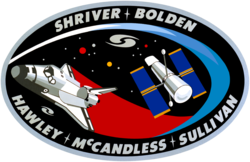STS-36
| STS-36 | |||||
 | |||||
| Uppdrag | 34 | ||||
|---|---|---|---|---|---|
| Rymdfärja | Atlantis (6)[1] | ||||
| NSSDC-ID | 1990-019A[2] | ||||
| Färdens tid | 4 dagar, 10 timmar, 18 minuter, 22 sekunder | ||||
| Uppskjutning | |||||
| Startplats | Startplatta 39A vid Kennedy Space Center i Florida | ||||
| Start | 28 februari 1990, 2:50:22 a.m. EST | ||||
| Landning | |||||
| Landningsplats | Edwards Air Force Base | ||||
| Landning | 4 mars 1990, 10:08:44 a.m. PST | ||||
| Omloppsbana | |||||
| Varv | 71 st[3] | ||||
| Apogeum | 204 km | ||||
| Perigeum | 198 km | ||||
| Banlutning | 62,0° | ||||
| Sträcka | 3,089 miljoner km | ||||
| Besättning | |||||
| Befälhavare | John O. Creighton (2) | ||||
| Pilot | John H. Casper (1) | ||||
| Uppdragsspecialister | Richard M. Mullane (3) David C. Hilmers (3) Pierre J. Thuot (1) | ||||
 | |||||
| Kronologi Rymdfärjeprogrammet | |||||
| |||||
STS-36 var den trettiofjärde flygningen i det amerikanska rymdfärjeprogrammet och sjätte i ordningen för rymdfärjan Atlantis. Den sköts upp från Pad 39A vid Kennedy Space Center i Florida den 28 februari 1990. Efter drygt fyra dagar i omloppsbana runt jorden återinträdde rymdfärjan i jordens atmosfär och landade vid Edwards Air Force Base i Kalifornien.
Flygningen gjordes på uppdrag av USA:s försvarsdepartement.
Se även
Referenser
- ^ NASA Space Shuttle Launch Archive Arkiverad 27 maj 2010 hämtat från the Wayback Machine., läst 28 juli 2016.
- ^ ”NASA Space Science Data Coordinated Archive” (på engelska). NASA. https://nssdc.gsfc.nasa.gov/nmc/spacecraft/display.action?id=1990-019A. Läst 18 mars 2020.
- ^ Manned Astronautics - Figures & Facts Arkiverad 6 maj 2015 hämtat från the Wayback Machine., läst 28 juli 2016.
Externa länkar
 Wikimedia Commons har media som rör STS-36.
Wikimedia Commons har media som rör STS-36.
| ||||||||
| ||||||||||||||||||||||||||||||||
Media som används på denna webbplats
STS-32 Mission Insignia
- The STS-32 patch, designed by the five crewmembers for the January, 1990 space mission, depicts the Space Shuttle orbiter rendezvousing with the Long Duration Exposure Facility (LDEF) satellite from above and the Syncom satellite successfully deployed and on its way to geosynchronous orbit. Five stars represent the mission number with three on one side of the orbiter and two on the other. The seven major rays of the sun are in remembrance of the crewmembers for STS 51-L. In preparation for the first Extended Duration Orbiter (EDO) missions, STS-32 conducted a number of medical and middeck scientific experiments. The caduceus on the left represents the medical experiments, and the crystalline structure on the right represents the materials science. The crew is comprised of Astronauts Daniel C. Brandenstein, James D. Wetherbee, Bonnie Dunbar, Marsha S. Ivins, and G. David Low.
Författare/Upphovsman: Pascal (Flickr user: pasukaru76), Licens: CC0
Vostok spacecraft replica at the Technik Museum Speyer, Germany.
STS-36 Mission Insignia
The STS-36 crew portrait features 5 astronauts who served in the 6th Department of Defense (DOD) mission. Posed near the Space Shuttle Orbiter Discovery are (left to right) Pierre J. Thuot, mission specialist 3; John H. Caster, pilot; John H. Creighton, commander; Richard M. (Mike) Mullane, mission specialist 1; and David. C. Hilmers, mission specialist 2. The crew launched aboard Atlantis on February 28, 1990 at 2:50:22am (EST).
STS-31 shuttle mission flight insignia. The mission insignia for NASA's STS-31 mission features the Hubble Space Telescope (HST) in its observing configuration against a background of the universe it will study. The cosmos includes a stylistic depiction of galaxies in recognition of the contribution made by Sir Edwin Hubble to our understanding of the nature of galaxies and the expansion of the universe. The STS-31 crew points out that is it in honor of Hubble's work that this great observatory in space bears his name. The depicted Space Shuttle trails a spectrum symbolic of both the red shift observations that were so important to Hubble's work and new information which will be obtained with the HST. Encircling the art work, designed by the crew, are the names of its members.






